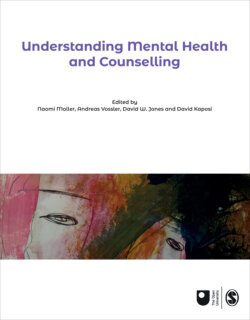Читать книгу Understanding Mental Health and Counselling - Группа авторов - Страница 47
На сайте Литреса книга снята с продажи.
1 The first two editions of the DSM
ОглавлениеThe DSM is based on the premise that mental health concerns can be medicalised. Prior to the first edition of the DSM, a number of different diagnostic systems were in use. Often these were focused on gathering basic statistics about patients in asylums and concentrated predominantly on psychoses. In 1946 the US War Department published a classification system called Medical 203 (War Department Technical Bulletin, Medical 203, 1946) organised around a categorical system of diagnosis. This was a broad system that focused on two ‘types’ of problems: those seen as primarily organic in origin and those seen as more psychological in origin. The term ‘disorder’ was used to refer to major categories but, for subcategories, the term ‘reaction’ was used. This reflected a broadly psychodynamic tradition in US psychiatry that saw problems arising from a dynamic interaction of biology, personality and social circumstances.
Medicalise To treat mental health concerns as though they are medical conditions that can therefore be diagnosed and treated.
Categorical system of diagnosis A system of organising diagnoses that assumes that mental health problems are distinct – that they have clear boundaries – and can, therefore, be differentiated from each other using diagnostic criteria.
Published in 1952, the first edition of the DSM (APA, 1952) was designed to be consistent with the ICD-6 (WHO, 1949) – the term ‘reaction’ was used both in the DSM and ICD. The DSM was heavily influenced by Medical 203 and was essentially a nine-page list of categories and codes followed by a longer section providing definitions and symptom descriptions. The categories were organised based on presumed causes. Sections with presumed organic and biological causes, such as ‘mental deficiency’, were differentiated from disorders seen as having psychological origins, including ‘psychotic disorders’, ‘psychoneurotic reactions’ and ‘personality disorders’ (which had been included in Medical 203 as ‘character and behaviour disorders’).
The second edition of the DSM (DSM-II) was published in 1968 (APA, 1968) and was designed to be consistent with the new ICD-8 (WHO, 1968), the development of which had been heavily influenced by US psychiatrists. Both used the term ‘reaction’ much less, and anxiety and depression were categorised as neuroses rather than ‘reactions’. By the end of the 1950s most psychiatrists worked in outpatient clinics and private practice (Cromby, Harper and Reavey, 2013), so DSM-II covered a broader range of problems than the first edition, including a new section specifically devoted to ‘behaviour disorders of childhood and adolescence’. Although some categories were still influenced by causal theories, the foreword to DSM-II noted that, where there was some controversy about the nature or cause of a disorder, ‘the Committee has attempted to select terms which it thought would least bind the judgment of the user’ (APA, 1968, p. viii).
Neurosis A psychiatric term that refers to a psychological state that causes distress but is not characterised by being out of touch with reality. Depression and anxiety are common examples.
In summary, the DSM arose out of the need to collect statistics on the prevalence and demographics of various disorders, and to develop a classification system consistent with the ICD for use across the US. The system was influenced by ideas about the causes of certain problems and by the populations with which it was to be used.
